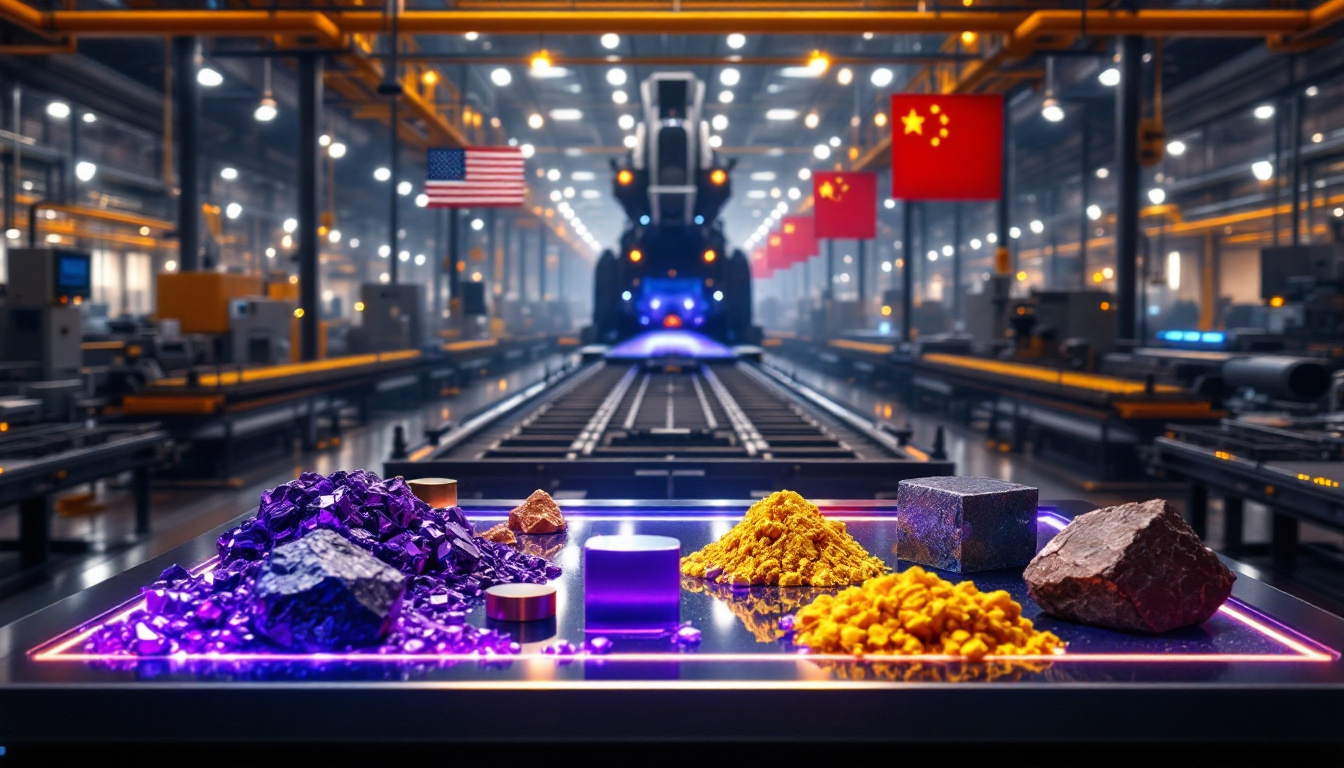EXIM Bank Financing for Ivanhoe's Santa Cruz Copper Project: Strategic Implications and Economic Impact
The Export-Import Bank of the United States (EXIM Bank) has expressed significant interest in Ivanhoe Electric's Santa Cruz Copper Project through a letter of intent to provide up to US$825 million (A$1.3 billion) in debt financing. This commitment aligns with EXIM Bank's 'Make More in America' initiative, which aims to bolster domestic production of critical minerals, reduce reliance on foreign supply chains, and address strategic vulnerabilities in the U.S. industrial base. Located in Arizona and fully owned by Ivanhoe Electric—a U.S.-based company—the Santa Cruz Project represents a cornerstone of national efforts to secure copper supplies for infrastructure, defense, and emerging technologies.
With a Preliminary Feasibility Study (PFS) slated for completion in June 2025 and construction anticipated to begin in early 2026, the project underscores the intersection of economic growth, national security, and technological innovation. The Santa Cruz development stands to become a crucial part of America's strategy to secure its domestic copper supply chain at a time when global demand is projected to surge dramatically over the coming decades.
What is the EXIM Bank's Interest in Ivanhoe's Santa Cruz Project?
Understanding the EXIM Bank's Letter of Interest
The EXIM Bank's offer of up to US$825 million in debt financing for the Santa Cruz Project reflects a targeted effort to strengthen domestic mineral production under its 'Make More in America' and China and Transformational Exports (CTE) programs. These initiatives prioritize projects that enhance U.S. competitiveness in sectors deemed critical for national security, such as rare earth elements, battery metals, and copper.
By supporting Ivanhoe Electric, EXIM Bank aims to mitigate critical mineral shortages exacerbated by the nation's current dependence on imports for over 80% of its critical minerals, including 14 minerals with zero domestic production. This financing approach represents a shift in U.S. industrial policy, recognizing minerals like copper as strategic assets rather than mere commodities.
The financing package is contingent on Ivanhoe meeting due diligence requirements, EXIM Bank's authorization processes, and compliance with eligibility criteria, which emphasize job creation, technological innovation, and long-term economic resilience. Industry analysts note that this level of federal backing signals confidence in the project's technical feasibility study insights and economic viability.
Strategic Significance of the Financing Offer
EXIM Bank's involvement signals a deliberate shift toward fortifying domestic supply chains for materials essential to clean energy, defense systems, and digital infrastructure. Copper, a linchpin of electrification and telecommunications, is particularly prioritized given projections of a 400% increase in global demand by 2050, driven primarily by renewable energy infrastructure and electric vehicle manufacturing.
The Santa Cruz Project's ability to produce high-purity copper cathode on-site eliminates the need for overseas refining, thereby reducing logistical vulnerabilities and carbon emissions associated with international shipping. This vertical integration represents a significant advantage in an industry where refining capacity is often concentrated in regions with geopolitical tensions.
Furthermore, the project's location on private land in Arizona streamlines permitting processes, avoiding delays common to federal lands and accelerating production timelines. This strategic alignment with national objectives positions Santa Cruz as a model for future public-private partnerships in critical mineral development, potentially creating a template for accelerating other domestic mining projects.
How Does the Santa Cruz Copper Project Support the U.S. Critical Mineral Strategy?
Santa Cruz Project Overview
The Santa Cruz Copper Project, 100% owned by Ivanhoe Electric (TSX:IE; NYSE:IE), is situated on private land in Arizona, a state with a rich mining heritage and supportive regulatory framework. The project's on-site cathode production capability distinguishes it from conventional copper mines, which often export raw concentrates for overseas processing, creating a vulnerability in the supply chain.
With a PFS expected in mid-2025, Ivanhoe has received indication for up to $825 million in financing from EXIM Bank as the company accelerates permitting and engineering work, targeting initial construction in the first half of 2026. The company's proprietary Typhoon™ geophysical surveying technology has enabled high-resolution subsurface imaging, optimizing resource delineation and minimizing environmental disruption—a technological edge that few competitors possess.
Geological assessments indicate that the Santa Cruz deposit contains unusually high copper grades for a North American project, with preliminary data suggesting grades of 0.7-1.2% copper, significantly above the global average of 0.5%. These advancements position Santa Cruz to produce approximately 60,000 metric tons of copper annually, addressing 5% of current U.S. demand and potentially serving as an anchor for a broader revival of domestic copper production.
Meeting Critical National Needs
The U.S. Department of Energy identifies copper as a "critical mineral" due to its irreplaceable role in renewable energy systems, electric vehicles (EVs), and grid infrastructure. Despite this designation, the U.S. imports over 40% of its copper, with reliance on foreign sources reaching 100% for 14 other critical minerals, creating significant national security and economic vulnerabilities.
The Santa Cruz Project directly counteracts this vulnerability by establishing a fully domestic supply chain—from extraction to cathode production—ensuring compliance with Buy America provisions in federal infrastructure contracts. This vertical integration is particularly valuable as the U.S. plans to invest over $50 billion in grid infrastructure over the next decade, all requiring substantial copper clean energy investments.
Executive Chairman Robert Friedland emphasized this strategic imperative, stating, "The U.S. urgently needs domestically produced copper to rebuild its electric transmission networks and sustain defense technologies." By localizing production, Ivanhoe mitigates risks posed by geopolitical tensions and trade disruptions, particularly in copper-rich regions like Chile and Peru, which account for 38% of global output but face increasing resource nationalism and regulatory uncertainty.
What Makes Ivanhoe's Project Strategically Important?
Executive Perspectives on the Project
Ivanhoe's leadership has consistently framed the Santa Cruz Project as a response to systemic vulnerabilities in U.S. resource security. CEO Taylor Melvin noted, "Santa Cruz is uniquely positioned to meet rising demand for domestically sourced copper, which is the backbone of the energy transition." This sentiment echoes broader industry calls for policy support, including tax incentives for mine development and streamlined permitting under the National Environmental Policy Act (NEPA).
The project's integration of advanced technologies, such as automated drilling and real-time ore sorting, further enhances its appeal as a modern, efficient operation capable of competing globally. These innovations are expected to reduce both environmental impact and production costs, with preliminary estimates suggesting operating expenses 15-20% below industry averages for similar-sized operations.
Industry experts point out that the Santa Cruz project represents one of the few near-term domestic copper developments with both the scale and metallurgical characteristics to significantly impact U.S. supply security. The project's emphasis on producing finished copper cathode rather than intermediate concentrates eliminates a key vulnerability in the current supply chain, where processing capacity is largely controlled by China and other competitors.
Competitive Advantages of Santa Cruz
The project's advanced development stage, private land status, and U.S. ownership provide distinct advantages over peer initiatives. Unlike projects on federal land, Santa Cruz avoids the lengthy NEPA review process, which can add 7–10 years to permitting timelines—a critical advantage in a market where copper price dynamics are expected to show supply deficits by 2025.
Additionally, Ivanhoe's vertical integration—from exploration to cathode production—ensures greater control over quality and costs, with preliminary estimates suggesting a 20% reduction in operating expenses compared to offshore refining. The project employs innovative heap leaching and solvent extraction-electrowinning (SX-EW) techniques that allow for efficient extraction of copper from lower-grade ores that might otherwise be uneconomical.
The company's commitment to zero-discharge water recycling and solar-powered infrastructure further aligns with federal sustainability goals, enhancing eligibility for additional grants under the Inflation Reduction Act. Metallurgical testing indicates the Santa Cruz ore body is particularly amenable to these environmentally friendly processing methods, with recovery rates exceeding 85%—significantly higher than the 60-70% typically achieved in similar operations.
What is the Current Development Status and Timeline?
Project Development Milestones
Ivanhoe has meticulously structured the Santa Cruz Project's timeline to align with federal funding cycles and market demand. The PFS, scheduled for June 2025, will provide detailed resource estimates, production targets, and financial models to secure project financing. Early geotechnical work has already identified optimal locations for processing facilities and tailings storage, minimizing both environmental impact and capital expenditure.
Concurrently, the company is advancing state-level permits under Arizona's Mine Reclamation Act, which mandates rigorous environmental safeguards but offers faster approvals than federal processes. Hydrological studies have confirmed sufficient water resources for the operation, with plans to implement advanced water recycling technologies that will reduce consumption by up to 75% compared to conventional copper mining operations.
Assuming timely approvals, initial construction will commence in Q1 2026, with first production anticipated by late 2028. This timeline capitalizes on projected copper price increases, driven by EV adoption and grid expansion, which analysts expect to reach US$12,000 per metric ton by 2030—approximately 30% higher than current levels. The project's modular design allows for staged development, reducing initial capital requirements while maintaining flexibility to expand as market conditions warrant.
Financing Considerations
While EXIM Bank's letter of interest is a pivotal milestone, Ivanhoe is evaluating complementary financing options, including strategic partnerships, green bonds, and Department of Energy loans under Title XVII. The company's NYSE listing provides access to equity markets, though CEO Melvin emphasized a preference for debt financing to avoid shareholder dilution.
EXIM Bank's due diligence will focus on the project's creditworthiness, environmental compliance, and adherence to Davis-Bacon wage standards, which require prevailing wages for construction workers. Industry analysts estimate that meeting these requirements will add approximately 8-12% to construction costs compared to non-federally backed projects, but the long-term benefits of secured financing outweigh these expenses.
Successful completion of these steps could set a precedent for EXIM's involvement in other critical mineral projects, leveraging its $3 billion annual lending capacity for strategic industries. Financial models suggest the Santa Cruz project could achieve a payback period of 4-5 years based on current copper price projections, making it an attractive investment despite the capital-intensive nature of copper mining.
How Does This Project Fit into the Broader U.S. Critical Minerals Strategy?
U.S. Critical Minerals Landscape
The U.S. critical minerals strategy, formalized through Executive Order 13817, identifies 50 minerals essential to economic and national security. Of these, 43 are imported in quantities exceeding 50% of annual consumption, with 14 entirely reliant on foreign sources—a vulnerability that has prompted bipartisan calls for domestic resource development.
Copper's dual role—as a critical mineral and a backbone of infrastructure—places it at the center of policy initiatives, including the Defense Production Act Title III, which prioritizes investments in mining and processing. A single EV requires approximately 83 kilograms of copper, four times the amount used in conventional vehicles, while renewable energy systems use up to five times more copper than fossil fuel alternatives.
The Santa Cruz Project directly addresses these gaps, with potential to supply 5% of domestic copper demand while serving as a template for future projects targeting lithium, cobalt, and rare earth elements. Geological assessments suggest that the American Southwest, including the region surrounding Santa Cruz, may contain up to 30% of North America's undiscovered copper resources, indicating potential for a broader revival of domestic production if initial projects prove successful.
EXIM Bank's Role in Critical Mineral Development
As the official export credit agency of the U.S., EXIM Bank has expanded its mandate under the 2021 CHIPS and Science Act to include domestic projects that reduce import dependence. The Bank's 'Make More in America' initiative, launched in 2022, allocates $1.3 billion annually to projects enhancing supply chain resilience, with a focus on clean energy and advanced manufacturing.
By offering debt financing, loan guarantees, and export credit insurance, EXIM complements initiatives like the Infrastructure Investment and Jobs Act, which earmarked $7 billion for battery material processing. The Bank's involvement in mineral projects represents a significant policy shift, as traditional financing for mining ventures has become increasingly scarce due to environmental, social, and governance (ESG) concerns among commercial lenders.
Santa Cruz's alignment with these priorities positions it to receive additional support, potentially including tax credits under Section 45X for domestic mineral production. Industry observers note that EXIM financing typically carries more favorable terms than commercial alternatives, with longer repayment periods (up to 18 years) and interest rates 1-2% below market averages for similar projects, potentially saving Ivanhoe tens of millions in financing costs over the project's lifetime.
FAQs About EXIM Bank and the Santa Cruz Copper Project
What is EXIM Bank and how does it support US projects?
EXIM Bank serves as the official export credit agency of the United States, providing crucial financial backing for projects that enhance American economic competitiveness and national security. Through its 'Make More in America' initiative, EXIM offers direct loans, loan guarantees, and insurance products specifically designed to strengthen domestic supply chains for critical materials and technologies.
Unlike traditional commercial lenders, EXIM Bank evaluates projects not only on financial metrics but also on strategic alignment with national priorities, such as reducing dependency on foreign mineral sources. For the Santa Cruz project, this approach translates to potentially longer loan terms (12-18 years versus the industry standard of 7-10 years) and more competitive interest rates, reflecting the project's contribution to resource security rather than merely its commercial returns.
The Bank's involvement in domestic mining represents an evolution of its traditional mandate, which historically focused on supporting U.S. exports rather than domestic production. This shift reflects growing recognition that secure supply chains begin with reliable domestic resource development, particularly for minerals like copper that face increasing global competition.
Why is copper considered a critical mineral for the United States?
Copper's designation as a critical mineral stems from its indispensable role in electrification, renewable energy, and defense applications. The average wind farm requires approximately 5.4 tons of copper per megawatt of capacity, while solar installations use about 5 tons per megawatt—quantities that cannot be substituted with alternative materials without significant performance losses.
In defense applications, copper's superior conductivity and corrosion resistance make it essential for advanced radar systems, missile guidance, and naval technologies. A single F-35 fighter jet contains over 900 pounds of copper, while military-grade communications systems rely on high-purity copper components to maintain signal integrity in extreme conditions.
Beyond these specialized uses, copper forms the backbone of America's aging electrical grid, which requires approximately $2 trillion in upgrades over the next two decades. This modernization will demand an estimated 5.5 million tons of additional copper—more than the current U.S. annual consumption—creating a strategic imperative to secure domestic supplies rather than increasing import dependency.
What makes the Santa Cruz project unique compared to other copper developments?
The Santa Cruz project distinguishes itself through several key advantages rarely found in combination within North American copper developments. Its location on private land circumvents the complex federal permitting process that has delayed comparable projects for up to a decade, while its fully domestic ownership structure aligns with national security objectives and Buy America requirements.
Geologically, the deposit features copper mineralization particularly suited to low-impact processing methods, with metallurgical testing demonstrating excellent recovery rates using heap leaching and SX-EW techniques. These methods require approximately 50% less water and energy than conventional flotation and smelting, significantly reducing both environmental impact and operating costs.
Perhaps most importantly, Santa Cruz's integrated mine-to-cathode approach eliminates dependence on overseas refining capacity, which has become increasingly concentrated in China. This vertical integration ensures that 100% of the value chain remains within U.S. borders, maximizing economic benefits while minimizing supply chain vulnerabilities that affect most domestic mining finance trends 2025.
What is the significance of domestic copper production for US national security?
The national security implications of domestic copper production extend well beyond the direct military applications of the metal. By reducing import dependency, projects like Santa Cruz strengthen America's resilience against supply disruptions caused by geopolitical tensions, trade restrictions, or conflict—vulnerabilities highlighted during recent global crises.
For critical infrastructure, domestically produced copper ensures compliance with increasingly stringent security requirements for power grids, telecommunications networks, and transportation systems. Federal agencies now mandate supply chain transparency for critical components, with materials originating from adversarial nations facing additional scrutiny or outright prohibition.
Looking forward, copper's role in energy independence cannot be overstated, as renewable technologies require 4-5 times more copper than fossil fuel alternatives. The Department of Defense has identifie
Ready to Spot the Next Major Mineral Discovery?
Stay ahead of the market with Discovery Alert's proprietary Discovery IQ model, delivering instant notifications on significant ASX mineral discoveries and transforming complex data into actionable investment insights. Explore our dedicated discoveries page to understand how historic mineral discoveries have generated substantial returns for early investors.




